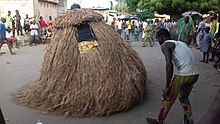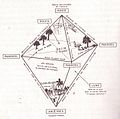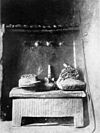Portal:Traditional African religions
Introduction The beliefs and practices of African people are highly diverse, including various ethnic religions. Generally, these traditions are oral rather than scriptural and are passed down from one generation to another through folk tales, songs, and festivals, and include beliefs in spirits and higher and lower gods, sometimes including a supreme being, as well as the veneration of the dead, and use of magic and traditional African medicine. Most religions can be described as animistic with various polytheistic and pantheistic aspects. The role of humanity is generally seen as one of harmonizing nature with the supernatural. In the past, African religion used to be referred to as 'traditional' but this is no longer appropriate. 'Traditional' was used to distinguish Africa religion from Abrahamic religion which came to the continent as a result of proselytism. Colonialism supported the false view that Africa had no religion. (Full article...) Selected article
The Serer creation myth is the traditional creation myth of the Serer people of Senegal, the Gambia and Mauritania. Many Serers who adhere to the tenets of the Serer religion believe these narratives to be sacred. Some aspects of Serer religious and Ndut traditions are included in the narratives contained herein but are not limited to them. The Serer people have many gods, goddesses and Pangool but one supreme deity and creator called Roog (or Koox in the Cangin languages). Serer creation myth developed from Serer oral traditions, Serer religion, legends, cosmogonies. The specifics of the myth are also found in two main Serer sources: A nax and A leep. The former is a short narrative for a short myth or proverbial expression, whilst the later is for a more developed myth. Broadly, they are equivalent to verbs and logos respectively, especially when communicating fundamental religious education such as the supreme being and the creation of the Universe. In addition to being fixed-Serer sources, they set the structure of the myth. The creation myth of the Serer people is intricately linked to the first trees created on Planet Earth by Roog. Earth's formation began with a swamp. The Earth was not formed until long after the creation of the first three worlds: the waters of the underworld; the air which included the higher world (i.e. the sun, the moon and the stars) and earth. Roog is the creator and fashioner of the Universe and everything in it. The creation is based on a mythical cosmic egg and the principles of chaos. Selected imagesFestivalsThere are several religious festivals found in the various Traditional African religions. Some of these are listed below next to their corresponding religion :
Selected biographyBabacar Sedikh Diouf (Serer: Babakar Sidiix Juuf) is a Senegalese historian, author, researcher, campaigner against "Wolofization", a Pan-Africanist, and former teacher. He has written extensively about the history and culture of Senegal, Africa, and that of the Serer ethnic group to which he belong. He usually writes by the pen name Babacar Sedikh Diouf. Diouf was one of the first (if not the first) to explain the Serer religious significance of the Senegambian stone circles. His work published on July 7, 1980 on the Senegalese newspaper Le Soleil became headline news and was picked up by the prehistorian and archaeologist Professor Cyr Descamps and his colleague Professor Iba Der Thiam. Professor Descamps was one of the archaelogisgts who excavated the monuments back in the 1970s. On July 28, 1980, Professor Descamps issued a response to Diouf—thanking him for explaining the significance of the Senegambian megaliths which until then were unknown or undocumented. Some of that included the arrangement of the stones and their religious symbolism based on Serer numerlogy. In his joint paper with Iba Der Thiam – titled: La préhistoire au Sénégal: recueil de documents, published in 1982, Descamps and Thiam republished Diouf's work and reiterated their thanks to him for his work two years earlier. Selected quote
Ram Swarup quoted in Koenraad Elst (2002) Source: Swarup, Ram [in] Elst, Koenraad, Who is a Hindu? : Hindu Revivalist Views of Animism, Buddhism, Sikhism, and Other Offshoots of Hinduism, Voice of India (2002), p. 72, ISBN 9788185990743
Did you know
Related portalsTopicsFor more Traditional African religion topics, see Category:Traditional African religions.
CategoriesWikiProjectsThings you can doAssociated WikimediaThe following Wikimedia Foundation sister projects provide more on this subject:
Discover Wikipedia using portals |







































